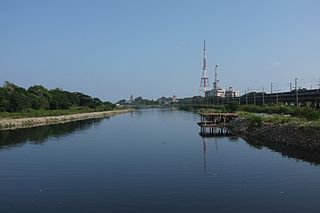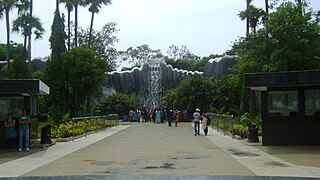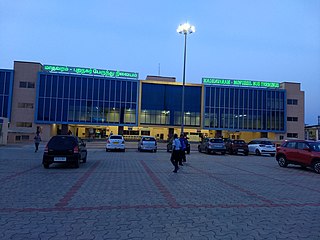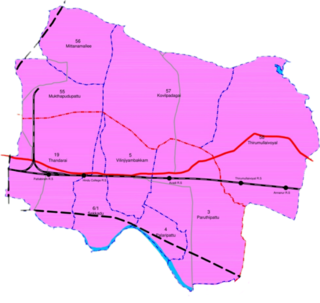
Chennai, formerly known as Madras, is the capital city of Tamil Nadu, the southernmost Indian state. It is the state's largest city in area and population, and is located on the Coromandel Coast of the Bay of Bengal. According to the 2011 Indian census, Chennai is the sixth-most populous city in India and forms the fourth-most populous urban agglomeration. The Greater Chennai Corporation is the civic body responsible for the city; it is the oldest city corporation of India, established in 1688—the second oldest in the world after London.

Avadi is a suburb of Chennai within Chennai Metropolitan Area limit, located in the Thiruvallur district of Tamil Nadu, India. It is a municipal corporation west of Chennai, about 22 kilometres (14 mi) from Chennai Central Railway Station. It is surrounded by major defence establishments and is home to various universities and engineering colleges. The city is served by Avadi Railway Station of the Chennai Suburban Railway. As of 2011, Avadi had a population of 345,996, which is 10th most populous place in Tamil Nadu. It is home to the Heavy Vehicles Factory (HVF), Ordnance Factory Board (ODF) which houses Engine Factory and Combat Vehicles Research and Development Establishment (CVRDE). The lake in Avadi was known as Paaleripattu, which is now found only in very old land documents.

The Cooum river, or simply Koovam, is one of the shortest classified rivers draining into the Bay of Bengal. This river is about 72 km (45 mi) in length, flowing 32 km (20 mi) in the city of Chennai and the rest in rural part. The river is highly polluted in the urban area (Chennai). Along with the Adyar River running parallel to the south and the Kosasthalaiyar River, the river trifurcates the city of Chennai and separates Northern Chennai from Central Chennai. It is also sometimes known as Thiruvallikenni river
The flora and fauna of Chennai are the plants and animals in Chennai, India.

Chembarambakkam lake is a lake located in Chennai, Tamil Nadu, India, about 25 km from Chennai. It is one of the two rain-fed reservoirs from where water is drawn for supply to Chennai City, the other one being the Puzhal Lake. The Adyar River originates from this lake. A part of water supply of the metropolis of Chennai is drawn from this lake. This was the first Artificial lake built by Rajendra Chola I the son of Rajaraja Chola and Thiripuvana Madeviyar, prince of Kodumbalur.

Tholkappia Poonga or Adyar Eco Park is an ecological park set up by the Government of Tamil Nadu in the Adyar estuary area of Chennai, India. According to the government, the project, conceived based on the master plan for the restoration of the vegetation of the freshwater ecosystems of the Coromandel Coast, especially the fragile ecosystem of the Adyar estuary and creek, was expected to cost around ₹ 1,000 million which will include the beautification of 358 acres of land. The park's ecosystem consists of tropical dense evergreen forest, predominantly comprising trees and shrubs that have thick dark green foliage throughout the year, with over 160 woody species, and comprises six vegetative elements such as trees, shrubs, lianas, epiphytes, herbs and tuberous species. The park was opened to public by Chief Minister M. Karunanidhi on 22 January 2011 and named after the renowned Tamil scholar Tholkappiar. About 65 percent of the park is covered by water and artefacts and signages. In the first 2 months of its inauguration, nearly 4,000 children from several schools in the city and the nearby Kancheepuram and Tiruvallur districts have visited the park to learn about wetland conservation, eco-restoration and water management. While the first phase of the ecopark covered about 4.16 acres of CRZ-III area, the entire area covered under the second phase falls under this category.

Ambattur aeri, or Ambattur lake, is a rain-fed reservoir which reaches top levels during the monsoon seasons. In November 2008, incessant monsoon rain filled the lake and encroachments on the north and south banks of the lake were demolished. It also caters to the drinking water needs of the Chennai city after Poondi and Chembarambakkam Lake.
Rettai Eri, locally known as Retteri, is a lake in the Kolathur area of Chennai, India which is visible from the 100 ft road. Redhills road Junction is also named as Retteri Junction. The Government has planned to construct a flyover at this junction.
Chennai Metropolitan Water Supply and Sewerage Board, known shortly as CMWSSB, is a statutory board of Government of Tamil Nadu which provides water supply and sewage treatment to the city of Chennai and areas around it.

Arignar Anna Zoological Park, also known as the Vandalur Zoo, is a zoological garden located in Vandalur, is in the southwestern part of Chennai, Tamil Nadu, about 31 kilometres (19 mi) from the Chennai Central and 15 kilometres (9.3 mi) from Chennai Airport. Established in 1855, it is the first public zoo in India. It is affiliated with the Central Zoo Authority of India. Spread over an area of 602 hectares, including a 92.45-hectare (228.4-acre) rescue and rehabilitation centre, the park is the largest zoological park in India. The zoo houses 2,553 species of flora and fauna across 1,265 acres (512 ha). As of 2012 the park houses around 1,500 wild species, including 46 endangered species, in its 160 enclosures. As of 2010, there were about 47 species of mammals, 63 species of birds, 31 species of reptiles, 5 species of amphibians, 28 species of fishes, and 10 species of insects in the park. The park, with an objective to be a repository of the state's fauna, is credited with being the second wildlife sanctuary in Tamil Nadu after Mudumalai National Park.

Pallikaranai wetland is a freshwater marsh in the city of Chennai, India. It is situated adjacent to the Bay of Bengal, about 20 kilometres (12 mi) south of the city centre, and has a geographical area of 80 square kilometres (31 sq mi). Pallikaranai marshland is the only surviving wetland ecosystem of the city and is among the few and last remaining natural wetlands of South India. It is one of the 94 identified wetlands under National Wetland Conservation and Management Programme (NWCMP) operationalised by the Government of India in 1985–86 and one of the three in the state of Tamil Nadu, the other two being Point Calimere and Kazhuveli. It is also one of the prioritised wetlands of Tamil Nadu. The topography of the swamp is such that it always retains some storage, thus forming an aquatic ecosystem. A project on 'Inland Wetlands of India' commissioned by the Ministry of Environment and Forests, Government of India had prioritised Pallikaranai marsh as one of the most significant wetlands of the country. The marsh contains several rare or endangered and threatened species and acts as a forage and breeding ground for thousands of migratory birds from various places within and outside the country. The number of bird species sighted in the wetland is significantly higher than the number at Vedanthangal Bird Sanctuary.

Chetpet lake is a lake spread over 16 acres in Chetput, Chennai, India. It is located to the north of Chetpet railway station. It is the only existing lake at the centre of the city. The lake belongs to the Department of Fisheries of the Tamil Nadu government.
Madhavaram Botanical Garden is a botanical garden in Chennai, India, set up by the horticulture department of the Government of Tamil Nadu. The garden, the second botanical garden in Chennai after the Semmoli Poonga, is the largest botanical garden in the city.
Chennai–Thiruvallur High Road, formerly known as Madras–Thiruvallur High Road, is one of the chief routes connecting the northwestern suburbs of Chennai, India. Starting from Padi Junction, the road connects the neighbourhoods of Padi, Ambattur, Thirumullaivoyil, Avadi, Pattabiram, Thirunindravur, and Thiruvallur. It is one of the four national highways that radiates out of Chennai city and is part of National Highway 205.
Ayappakkam is a village in Thiruvallur district in the Indian state of Tamil Nadu. Ayapakkam is currently a village panchayat surrounded by Thiruverkadu municipality, Avadi corporation and Greater Chennai Corporations.
The coastal city of Chennai has a metropolitan population of 10.6 million as per 2019 census. As the city lacks a perennial water source, catering the water requirements of the population has remained an arduous task. On 18 June 2019, the city's reservoirs ran dry, leaving the city in severe crisis.

Korattur Aeri, or Korattur Lake, also known as Vembu Pasumai Thittu, is a lake spread over 990 acres in Korattur, Chennai, India. It is located to the north of the Chennai–Arakkonam railway line. It is one of the largest lakes in the western part of the city.

Chitlapakkam aeri, or Chitlapakkam lake, is an urban lake located in Chitlapakkam, Chennai, India. It is the chief water body in the neighbourhood. Originally measuring 86.86 acres, the lake has currently shrunken to 46.88 acres. The lake was last restored in 2003.

Madhavaram Mofussil Bus Terminus (MMBT) is a satellite bus termini of Chennai, India, located in the neighbourhood of Madhavaram, providing outstation/inter-state transport services. Spread over an area of 8 acres (32,000 m2), it was built to decongest the Chennai Mofussil Bus Terminus in Koyambedu. It will chiefly handle buses to Andhra Pradesh and Telangana, including cities such as Chittoor, Tirupati, Nellore, Vijayawada, Kurnool, Puttaparthi, Visakhapatnam, Bhadrachalam, and Hyderabad. As of 2018, the number of passengers travelling from Chennai to these two states daily average 12,500. The Tamil Nadu and Andhra governments operate about 315 services daily, which increases during weekends.

Avadi City Municipal Corporation is the civic body governing the suburb of Avadi in Chennai, Indian state of Tamil Nadu. Municipal Corporation mechanism in India was introduced during British Rule with formation of municipal corporation in Madras (Chennai) in 1688, later followed by municipal corporations in Bombay (Mumbai) and Calcutta (Kolkata) by 1762. Avadi Municipal Corporation is headed by Mayor of city and governed by Commissioner. It is one of the three municipal corporations within the Chennai Metropolitan Area, the other two being the Greater Chennai Corporation and Tambaram City Municipal Corporation.














